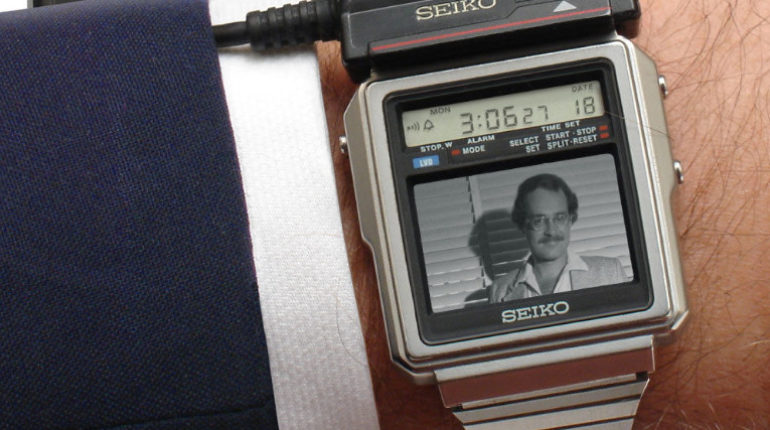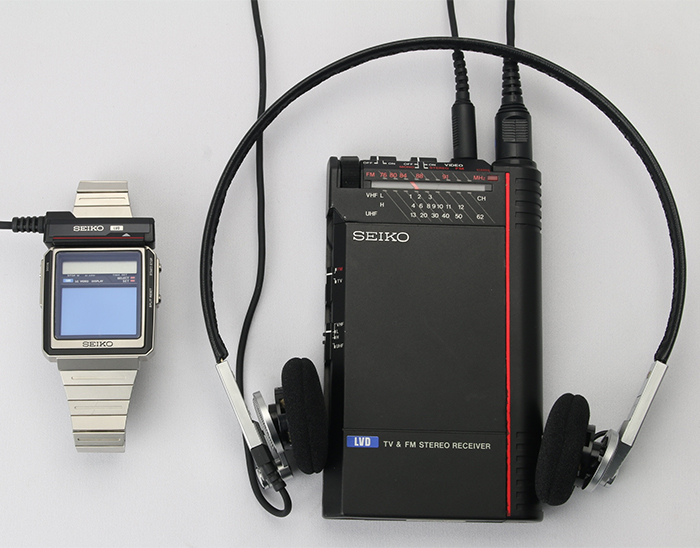The First TV Watch

In terms of today’s post, we don’t mean “watch” as in viewing, although that is an important aspect of the highlighted timepiece. In 1982, Seiko pulled out a smart watch long before the technology we know today. When digital watch technology hit the scene, it was game changing—as well as the quartz movement itself (the quartz revolution kicking off in the early 1970s). A decade after the first commercially released digital watch was debuted by Hamilton (valued at $12,000 today), digital watch tech had become inexpensive enough to explore building more futuristic timepieces.. Enter the Seiko TV Watch—in all of its LCD glory. This piece was one of the more impressive digital wristwatch experiments of the 1980s. Being one of the more difficult to design, costing over 100,000,000 Yen (~$400,000) to develop, it went against the grain of popular tube-tech televisions of that time—as well as wristwatch norms.
Employing liquid-crystal display technology was vital in making this watch work. Although cathode tubes were the most popular in building commercial televisions, until the early 21st century, LCD tech could run images with a lower power consumption rate. As well, it allowed for condensing images to smaller sizes. Though the Seiko TV Watch sacrificed a good amount of contrast and resolution to make the piece function, it could run for up to 5 hours at a time. Much to the fantasy of consumers, this could mean catching the game without leaving a business meeting, or committing some other covert act of entertainment. The word “covert” may not seem likely when looking at the receiver this timepiece required—however. Despite the watch portion of this technology being dubbed “the smallest TV set in the world” by Guinness World Records in 1984, it still required a 5×3 inch box receiver—attached by a wired cable—to transmit the TV signal. Bulky by today’s standards, and not particularly streamlined, this aspect of the Seiko TV watch was still relatively easy to hide—with the right garment. Clunkiness aside, nothing like it had existed before, so it was therefore a great way to feel like you were in on a secret no one else could ever fathom. So much so that even the popular secret agent film franchise James Bond employed this wristwatch in their 1983 film Octopussy, instead of their typical Rolex Submariner.

Originally only available in Osaka and Tokyo, Seiko sold its first 2,200 TV Watches at $425 within the first year. Seiko decided to broaden the market and make more models from this initial success. According to a 1983 New York Times article (easily searchable in their online archives, for a fun throwback), Robert L. Piskin—the head of Seiko’s U.S. operations at the time—claimed they could “…sell as many as we make”. The projected amount of watches to be manufactured and taken to both the U.S. and Japanes market was around 15-20,000 units. Costing around $495 in U.S. markets, this watch was not super accessible to everyone. But if you could swing it, you could be your very own secret agent. Or, at the very least, shirk some daily duties for some low-resolution catharsis. In today’s terms, the idea of watching television on the go isn’t as strange and exciting as it was nearly four decades ago. However, because of the creativity of Japanese engineers, along with the power of American popular culture, the conception of this type of tech lead to its ubiquity and newly imagined forms. As of this date, televisions don’t even require an analog signal like their old cathode counterparts. These analog signals have been off the airwaves since June 12, 2009, in fact (in the U.S.). With televisions, phones, and smartwatches connected to the internet via wi-fi radio signals and ethernet, our lives are lush with some fine everyday luxury. It can be easy to take everyday conveniences for granted—which is likely why novelty timepieces like the Seiko TV Watch still hold a fascination today. They remind us of the excitement of smaller and more technologically advanced gadgets making their way into our lives, in their early years of development. So, if you managed to get an original model from Seiko back in the early 80s, or are a collector looking for the crown jewel of old-school pocket televisions, enjoy the fascination. Though the Seiko TV Watch can’t be “turned on” or “tuned in” anymore, they’ll never “drop out” of style and nostalgic charm for the foreseeable future.
Times Ticking has been in operation for more than 30 years, since 1982. We have performed watch repair for customers both locally and internationally. If it Ticks! We KNOW it! Our team of watch repair technicians have a combined experience in watchmaking of over 120 years.

